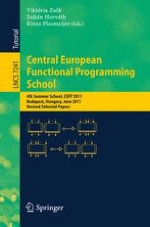2012 | Buch
Central European Functional Programming School
4th Summer School, CEFP 2011, Budapest, Hungary, June 14-24, 2011, Revised Selected Papers
herausgegeben von: Viktória Zsók, Zoltán Horváth, Rinus Plasmeijer
Verlag: Springer Berlin Heidelberg
Buchreihe : Lecture Notes in Computer Science
